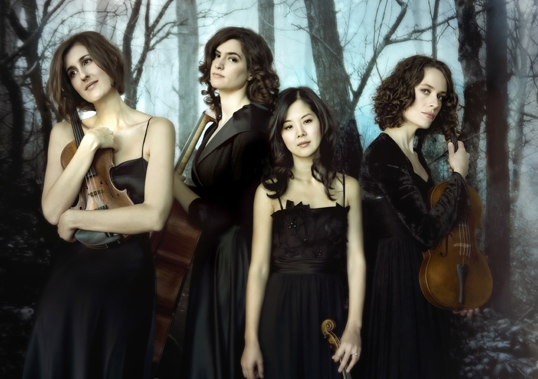Cecilia Quartet spans the centuries in Winter Chamber Music Festival opener

Now in its 16th season, Northwestern University’s Winter Chamber Music Festival has become a highly anticipated January event that gives chamber music lovers a real winter boost.
Friday night’s opening concert at Pick-Staiger Concert Hall was nearly full to capacity for a program by the Cecilia Quartet that was unusually eclectic: how often do you get a chance to hear quartets of Mozart and Hayden juxtaposed alongside works from the mid-20th century and the current post-millennial era?
Haydn not only perfected the symmetrical sonata form that would become the musical building block of Classicism, but also the genres of musical expression for both private and public performances. His younger colleague, Mozart, was immensely influenced by Haydn and the six quartets that Mozart dedicated to Haydn are Mozart’s best in that form. The earlier quartets had depended largely on Mozart’s uncanny gift for melodic invention, but here, Haydnesque structure meets Mozartean charm, an unparalleled combination.
Like the others in the set, Mozart’s Quartet No. 16 in E flat minor, K. 428 follows Haydn’s four-movement model but the piece is so astonishingly adventurous harmonically that many quartets prefer performing it as a precursor to Romanticism rather than advanced Classicism. The Cecilia Quartet made a convincing case for the Classical view, performing with straight tone and brisk tempos.
The Shostakovich Quartet No. 7 in F sharp minor is the briefest of the fifteen Shostakovich quartets, but nonetheless packs a real wallop in its compactness. Unlike the more introspective performance that the Pacifica Quartet gave of the work as part of its complete Shostakovich cycle last year, the Cecilia Quartet chose to make this a wild ride, even suggesting in short spoken remarks that the three-note “knocking” motif could be interpreted as the KGB coming after the fearful composer.
Certainly that program fit into the Cecilia interpretation that convincingly emphasized extremes of tension and release. The motif morphs from an accelerating heartbeat to outright knocking and almost a direct confrontation between the authorities and the composer before a return to the anxious tranquility that preceded it.
Stacy Garrop’s String Quartet No. 4, Illuminations, was commissioned by Nicholas Yasillo as an anniversary gift for his wife Susan, who has a passion for hand-illustrated and hand-copied medieval versions of the daily prayer of the church known as the Divine Office.
The piece is specifically designed to be an aural rendering of five elaborately illuminated pages of an anonymous Dutch artist for the 1442 Hours of Catherine of Cleves, currently housed in New York City’s Morgan Library & Museum.
Using a modus operandi similar to Mussorgsky’s Pictures at an Exhibition, the work also seeks to create a unifying motif that in this case represents turning pages of the book. The opening spotlights a shimmering chromaticism with starts and stops as if the contemplative prayer-seeking “reader” is thumbing through pages sometimes leisurely, sometimes quickly, before arriving at an illumination of Catherine praying before Virgin and Child. To make that aural jump, the quartet becomes decidedly more diatonic, making glissandi in and out of a plainchant Ave Maria with pedal points.
And so it goes: an angel illumination is represented by upper harmonics and a hell illumination is portrayed via low notes and widely spaced octaves across the ensemble; the music then turns dance macabre-like and exploits the tri-tone before coming back to Dresden Amen-like reality. The piece is engaging, to be sure, but literalistic in its program, thus leaving little to the imagination.
Beethoven’s Quartet No. 16 in F Major, Op. 135 recalls his Ninth Symphony with its use of unison as a sonic narrator, as it were, of seemingly unrelated musical episodes.
This last quartet is short by standards of mature Beethoven quartets. Some musicians prefer to view it as a footnote to the more radical quartets, but the Cecilia Quartet clearly and convincingly takes the interpretive view that the work represents Beethoven’s nostalgia for his own earlier brand of expansive classicism.
The Cecilia Quartet’s performances of all four quartets could not be more remarkable, both for the diversity of styles on display and the wide variety of timbres that the Quartet employed to show each to its best effect.
All the more impressive was that the Garrop Quartet had been written specifically for them, and the musicians highlighted some of the post-millennial working process that brought the work into being, included downloads and e-mails between composer and performers to help generate a work rooted in an 18th -entury genre on a medieval subject.
Northwestern University’s Winter Chamber Music Festival continues 7:30 p.m. Sunday with a program of Penderecki, Kodály and Franck. (847) 467-4000; pickstaiger.org.
Posted in Performances




